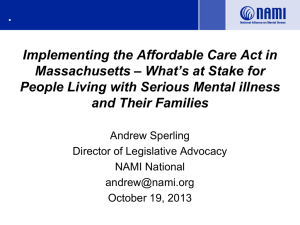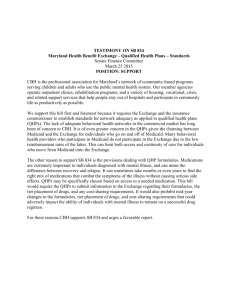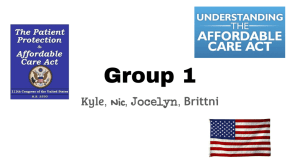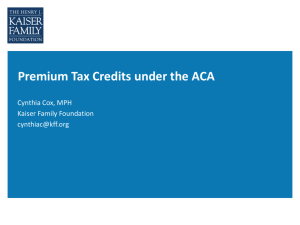Medicaid Expansion: State Considerations & Approaches
advertisement
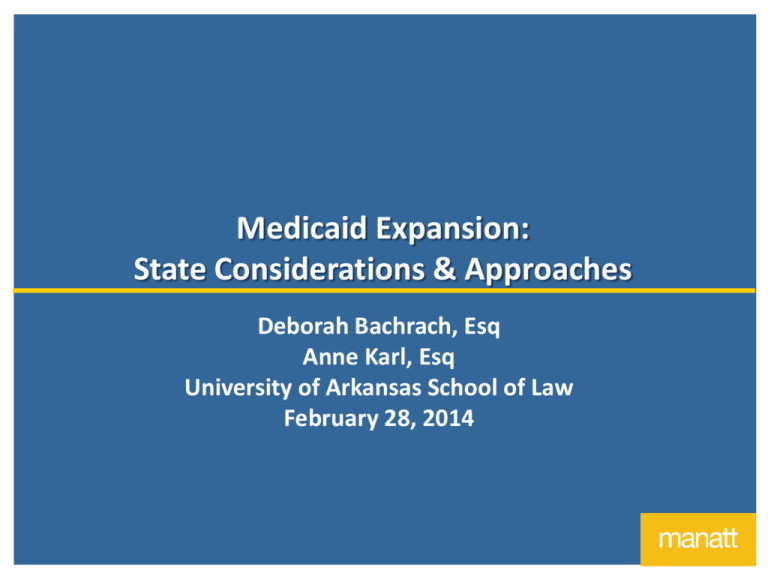
Medicaid Expansion: State Considerations & Approaches Deborah Bachrach, Esq Anne Karl, Esq University of Arkansas School of Law February 28, 2014 Medicaid in the ACA Coverage Continuum 100% FPL 0% 138% 100% Medicaid expansion to childless adults and parents 200% 300% 400% 400% Medicaid eligibility levels vary by state Insurance Affordability Programs (“IAPs”) CHIP eligibility levels vary by state Premium Tax Credits and Cost-Sharing Reductions for Qualified Health Plans Qualified Health Plans Employer Sponsored Insurance 2 Medicaid Expansion: In State’s Hands 3 Who Can the Expansion Cover? At What Matching Rate? The New Adult Group Under age 65 Year Enhanced Federal Matching Rate Newly Eligible Adults up to 138% FPL Income below 138% FPL State Share Federal Share 2014 0% 100% 2015 0% 100% 2016 0% 100% 2017 5% 95% 2018 6% 94% 2019 7% 93% 2020+ 10% 90% Not pregnant Not entitled to or enrolled in Medicare Part A Not in any other mandatory Medicaid eligibility group 4 What Benefits Do New Adults Receive? The Alternative Benefit Plan (ABP): Must include all 10 essential health benefits (EHBs) Must meet mental health parity Must cover EPSDT for 19 and 20 year olds Must cover non-emergency transportation 5 Fiscal Impact of Coverage Expansion COSTS • • • State share of costs for newly eligibles after 2016 Currently eligibles stepping forward for coverage (some of this may happen due to ACA in any case) Administrative costs of a larger program SAVINGS • Moving current Medicaid populations into new adult group (e.g. pregnant women, medically needy and waiver populations), for which state receives enhanced matching rate • Replacing state funding for programs for the uninsured (e.g. high risk pool, substance abuse/mental health programs) with Medicaid funds REVENUE • Provider Taxes/Assessment • Plan Taxes/Assessment 6 Medicaid Expansion Decisions for 2014 Washington Montana Oregon North Dakota Idaho Wyoming Nevada Vermont Minnesota Wisconsin South Dakota Nebraska Iowa Utah Pennsylvania Illinois Indiana Ohio Colorado California Kansas Arizona New Mexico New York Michigan Oklahoma West Virginia Missouri Maine New Hampshire Massachusetts Rhode Island Connecticut New Jersey Delaware Maryland Virginia Kentucky North Carolina Tennessee Arkansas South Carolina Georgia Alaska Moving Forward at this Time (25 + DC) Texas Florida Hawaii Louisiana Alabama Not Moving Forward at this Time (24) Mississippi Waiver Pending (1) 64% of Uninsured Live in Non-Expansion States and About 4.8 Million will Fall Into Coverage Gap 7 Source of Uninsured Data: Urban Institute and Kaiser Family Foundation Non-Expansion States: The “Coverage Gap” 8 Who Is In the Coverage Gap? 4.8 million uninsured adults fall in the coverage gap 2.6 million (over half) are people of color 8.7 million people of color are uninsured and below 138% FPL. 30% of these individuals (2.6 million) fall in the coverage gap 9 Emerging Approaches to Coverage Expansions 10 States Are Considering Medicaid Expansion Options 11 Dynamic Federalism STATES MEDICAID HHS 12 States are Exploring Alternative Coverage Models Non-expansion states remain under pressure from powerful stakeholders including hospitals, chambers of commerce and local governments States are seeking their own expansion pathways Premium Assistance for Employer Sponsored Insurance (ESI). To prevent Medicaid-eligible adults from dropping ESI, Medicaid programs will wrap around premiums, cost-sharing and benefits. (SSA § 1906) Premium Assistance in the Marketplace. Medicaid buys QHP coverage for the expansion adults. Arkansas and Iowa have obtained federal approval to move forward with this approach. (42 CFR § 435.1015) Premiums and Cost-Sharing. States are increasingly looking to require co-payments and premiums, seeking federal waivers where necessary. Health Incentives. States are seeking to incent healthy behaviors by forgiving co-pays and/or premiums to meeting certain health standards. 13 Medicaid Premium Assistance: For Employer Sponsored Insurance ESI Coverage Employer Medicaid • Wraps benefits and covers consumer’s premiums and cost-sharing beyond Medicaid limits Iowa will use mandatory Premium Assistance for Medicaid eligible individuals with access to ESI (in addition to Premium Assistance in the Individual Market for 100-133% FPL) New Hampshire’s Medicaid Expansion Study Commission recommended mandatory Premium Assistance for Medicaid eligible individuals with access to ESI (in addition to Premium Assistance in the Individual Market for 100-133% FPL) 14 Medicaid Premium Assistance: In the Individual Market QHP Coverage In 2014 Arkansas will purchase coverage for all childless adults and parents 17-133% FPL through QHPs in the Marketplace Medicaid Iowa will purchase coverage for newly eligible adults 100-133% FPL through QHPs in the Marketplace • • • Purchases QHP coverage for Medicaid eligible new adults Covers cost of premiums Wraps missing benefits and excessive cost-sharing Pennsylvania has proposed purchasing coverage for all newly eligible adults through QHPs in the Marketplace 15 Medicaid Premium & Cost-Sharing Rules < 100% FPL 100% - 149% FPL ≥ 150% FPL 5% household income 5% household income 5% household income Not allowed Not allowed Permitted, subject to aggregate cap Maximum Allowable Medicaid Premiums and Cost-Sharing Aggregate Cost-Sharing Cap Premiums Maximum Service-Related Co-pays/Co-Insurance Outpatient services $4 10% of cost the agency pays 20% of cost the agency pays Non-emergency ER $8 $8 No limit Preferred: $4 Non-Preferred: $8 Preferred: $4 Non-Preferred: $8 Preferred: $4 Non-Preferred: 20% of cost the agency pays $75 per stay 10% of total cost the agency pays for the entire stay 20% of total cost the agency pays for the entire stay Rx Drugs Institutional Specific populations are exempt from cost-sharing requirements (e.g., pregnant women, spend-down beneficiaries, and individuals receiving hospice). However, exempt individuals may be charged cost-sharing for non-preferred drugs and non-emergency use of the emergency room Cost sharing cannot be mandatory for individuals with household incomes < 100% FPL If non-preferred drugs are medically necessary, preferred drug cost sharing applies Source: SSA § 1916 and 1916A 16 Emerging Approaches to Personal Responsibility INVOICE INVOICE Visit to Clinic $8 Behavioral Health Outpatient Visit $4 Generic Rx $4 Name brand Rx $8 Inpatient/per day $140 Premiums? Health Incentives? Work Referral? Work Requirements? 17 Comparison of State Waivers for New Adults Premium Assistance for QHPs Arkansas Iowa Michigan Pennsylvania (pending submission) Cost-Sharing Premiums Healthy Behavior & Work Incentives Benefits Yes Yes All childless adults 100-133% FPL in 0-133% FPL year one Parents 17-133% Wide range of FPL services No No (in year one) Any healthy behavior incentive programs will be established through QHPs All benefits covered under the Alternative Benefit Plan Yes All adults 100133% FPL Yes 100-133% FPL only Limited to nonemergency use of the ER Yes 100-133% FPL only Up to 2% of income Payment is not a condition of eligibility Yes May reduce premium obligations All benefits covered under the ABP except nonemergency medical transportation (NEMT). NEMT waived for one year. No Yes Childless adults 0133% FPL Parents 55-133% FPL Wide range of services Yes 100-133% FPL only 2% of income Payment is not a condition of eligibility Yes May reduce premium and cost-sharing obligations All benefits covered under the Alternative Benefit Plan Yes Yes 50-133% FPL only May reduce premium Up to $25 per month for obligations one adult or $35 per Includes work month for more than one requirements adult (> than QHP premiums) Requests waiver of requirement to provide benefits beyond those covered by qualified health plans (e.g., FQHCs, NEMT) Yes Yes All childless adults 0-133% FPL 0-133% FPL Limited to non All parents 33emergency use of 133% FPL the ER Expansion, Reform & Simplification Work Together Coverage Expansions Payment & Delivery Reform Administrative Simplification 19 Medicaid Payment & Delivery Reform Medicaid is becoming a more sophisticated purchaser, and states are using: • Coordinated care models (ex: patient centered medical homes, health homes) • Outcomes-based incentives (ex: pay for performance) • Value-driven reimbursement (ex: bundled payments) • Continued penetration of Medicaid managed care, to more populations and with a broader range of benefits States are motivated by pressure to reduce state expenditures, the availability of federal funding and momentum toward improving quality of care States may use 1115 waivers to take advantage of flexibilities: • To craft alternatives to Medicaid expansion • To create “Delivery System Reform Implementation Pools” (funding pools) • To reform long-term care systems • To make sweeping, innovative changes to state health care systems (via State Innovation Model grants) 20 THANK YOU Deborah Bachrach, Esq. Partner Manatt, Phelps & Phillips Dbachrach@manatt.com Anne Karl, Esq. Associate Manatt, Phelps & Phillips Akarl@manatt.com 21

